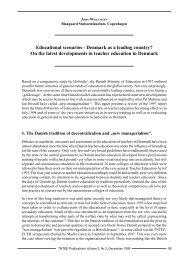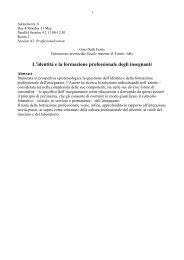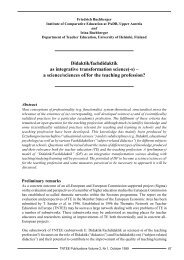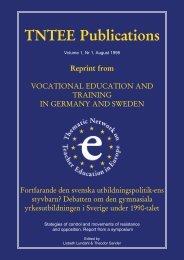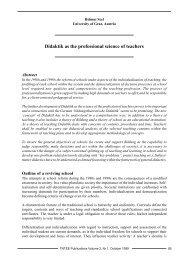TNTEE Publications - Didaktik/Fachdidaktik
TNTEE Publications - Didaktik/Fachdidaktik
TNTEE Publications - Didaktik/Fachdidaktik
Create successful ePaper yourself
Turn your PDF publications into a flip-book with our unique Google optimized e-Paper software.
The Deutsche <strong>Didaktik</strong> and the American Research on Teaching<br />
teacher of how to organise the activities when teaching a special subject and choosing the content<br />
within this subject. The new conception of the teaching plan curriculum concentrated on every<br />
pupil and his/her learning.<br />
Thus, the curriculum was defined through the learning experiences, and common to various<br />
definitions was the focus on the individual pupil and the learning experiences which s/he was to<br />
encounter during his/her time at school (cf. Hosford 1973). If we take the broadest meaning of the<br />
curriculum, it consists of all the experiences organised during the time the school is responsible for<br />
the pupil. This also contains, by definition, such experiences which are not consciously planned but<br />
which are happening in the school. Thus, in this case there is no room left for the hidden curriculum<br />
because all the experiences are within the curriculum (cf. Jackson 1992, 4–12.).<br />
Gradually, the meaning of curriculum was broadening and as curriculum theory, its scope was<br />
nearly the same as traditional <strong>Didaktik</strong>. The word, das Curriculum, was directly taken into use<br />
without any special translation and its content was becoming more and more the same as <strong>Didaktik</strong><br />
with a particular emphasis of its own (cf. Frey 1971). Wolfgang Klafki (1974) wrote an article in a<br />
dictionary under the common heading “Curriculum – <strong>Didaktik</strong>” and it seemed that <strong>Didaktik</strong> would<br />
be subsumed under the more general curriculum. It was a radical interpretation of traditional <strong>Didaktik</strong><br />
and it showed a certain change in thinking about the old subdiscipline of education. It was, however,<br />
only a question of how to compare these two aspects which were parts of the more general <strong>Didaktik</strong>.<br />
In this article Klafki described the old directions of didactic models and in addition to that, the<br />
aspects of curriculum planning and controlling or evaluation. So one can say that it reflected at least<br />
a different conception of the problems of <strong>Didaktik</strong> and it had great influence on practical curriculum<br />
development.<br />
The research on curriculum problems concentrating on development, planning, and evaluation grew<br />
greatly during the 1970s and it reached its peak in the early 1980s. The results were reported in<br />
large handbooks (Frey 1975, Hameyer and Frey and Haft 1983): <strong>Didaktik</strong> and curriculum theory<br />
were considered as parallel areas of the same subdiscipline. During these years the emphasis was<br />
on curriculum theory and it had a very important role in the efforts to achieve school reform, and in<br />
particular in reforming the old teaching plans into a modern curriculum.<br />
It is not easy to define the curriculum, and difficulties arise because curriculum as a concept has<br />
numerous semantic contents and nuances depending on the context in which it is found and on the<br />
purpose for which it is used. Reisse (1975) points out that the term curriculum is strongly culturebound<br />
which is why comparison of its meanings across linguistic boundaries is fraught with a<br />
variety of difficulties. Additionally, of course, any term may also have several meanings within a<br />
specific cultural environment (cf. Connelly and Lantz 1985). The American influence of the<br />
implementation of the term curriculum can be evaluated from the point of view of planning and<br />
evaluation of education in institutes. The problems of formulating educational goals and objectives<br />
as guidelines for teaching practice were focused on, and methods of evaluation, both in the classroom<br />
and on the school level, became more important than before.<br />
The question of the relationship between <strong>Didaktik</strong> and curriculum has gradually lost its interest and<br />
the status quo seems to have been achieved. The impulses have come from the American research,<br />
but there is hardly any evidence of impulses in the opposite direction. One could conclude that the<br />
didactic aspects of curriculum have integrated into <strong>Didaktik</strong>. Zimmermann (1986) is of the opinion<br />
that discussion can be reinstated because we now know the good and bad sides of the problem.<br />
<strong>TNTEE</strong> <strong>Publications</strong> Volume 2, Nr 1, October 1999 25



